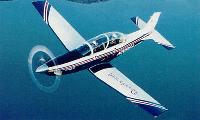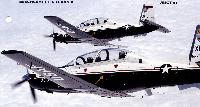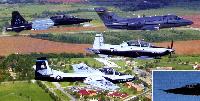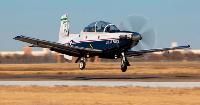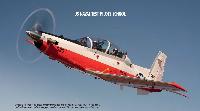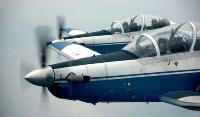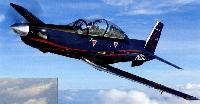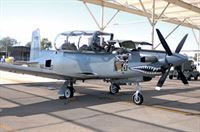
Описание
Страна : США
Год : 1995
Учебно-тренировочный самолет с экипажем из двух человек
Варианты
- Pilatus - PC-9 - 1984 - Швейцария
- Beechcraft - T-6A Texan II - 1995 - США
Beechcraft T-6 Texan II
В конце 1980-х годов ВВС США приступили к поиску претендента на замену основного УТС Cessna T-37. Была разработана программа PATS (Система базовой летной подготовки), затем она превратилась в JPATS ("J" - совместная), так как в 1990 году к ней присоединились ВМС. Основу перспективной системы должен был составить двухместный УТС с тандемным расположением кресел.
Компания "Raytheon" предложила на тендер свой проект на базе самолета Pilatus PC-9. В 1990 году к ней присоединились две другие компании, и вскоре два PC-9 были переданы компании "Beech" (сейчас "Beechcraft", подразделению "Raytheon"). Один из них позиционировали как прототип инженерно-технической разработки, чтобы уменьшить риски программы.
Затем в "Beech" создали два прототипа, поднявшихся в воздух соответственно в декабре 1992 года и июле 1993 года. Самолеты первоначально обозначили PD373, но позже они стали именоваться Beech 3000, а заказчикам они уже демонстрировались как Beech Mk II.
22 июня 1995 года "Raytheon" была объявлена победителем по программе JPATS и получила контракт на 372 самолета для ВВС и 339 - для ВМС США, с поставкой до 2014 года. Новый УТС получил обозначение T-6 Texan II. Первый опытный самолет совершил полет 15 июля 1998 года, в эксплуатацию для технической оценки самолет поступил в июне 1999 года, а поставки серийных машин начаты 1 марта 2000 года. Первая учебная эскадрилья ВВС приступила к перевооружению на самолеты Texan II с 23 мая 2000 года.
"Beechcraft" заявляет, что серийный T-6 не имеет общих деталей с PC-9, и действительно - американский самолет отличается новыми кабиной, фонарем, фюзеляжем, крылом, килем, надфюзеляжным гребнем и дополнительными подфюзеляжными гребнями.
ТАКТИКО-ТЕХНИЧЕСКИЕ ХАРАКТЕРИСТИКИ
T-6A Texan II
Тип: учебно-тренировочный самолет с экипажем из двух человек
Силовая установка: один ТВД Pratt & Whitney Canada PT6A-68 мощностью 820 квт(1100л.с)
Характеристики: максимальная скорость 585 км/ч (М=0,67); практический потолок 9448 м; дальность полета 1575 км; максимальная скороподъемность 1372 м/мин
Масса: пустого 2087 кг; максимальная взлетная 2958 кг
Размеры: длина 10,2 м; высота 3,3 м; размах крыла 10.2 м; площадь крыла 16,3 м'
Описание:
- Beechcraft T-6 Texan II
- Pilatus PC-9
Фотографии
-
Мировая Авиация 30
Кодировка "RA" на киле изображенного самолета T-6A ВВС США обозначает место его базирования - авиабаза Рзндольф, штат Техас. В Рэндольфе дислоцировано 12-е учебно-тренировочное авиакрыло, в состав которого входят 559-я учебно-тренировочная эскадрилья и пилотажная группа ВВС. Подготовка летчиков проводится также на авиабазах Логлин, штат Огайо, и Шиферд, штат Техас.
-
Jane's All the World Aircraft 2000 / 2-02 - AIRCRAFT - FIXED-WING - MILITARY/CIVIL
Artist's impression of T-6A Texan II in markings of USAF's 12th FTW (1998)
-
Мировая Авиация 44
Регистрационный номер: N8284M Выбор системы JPATS. Февраль 1996г.: УТС Raytheon Beech T-6A Texan II выбран в качестве "универсальной системы начальной летной подготовки экипажей" (JPATS) для замены УТС T-37 Tweet в ВВС и T-34C Turbo-Mentor в ВМС США. Самолет представляет собой американскую модификацию Pilatus PC-9 Mk II и оснащен турбовинтовым двигателем Pratt & Whitney PT6A-62. Для некоторых подобный выбор оказался неожиданным, считалось, что лучший вариант - самолет с турбореактивным двигателем.
-
Мировая Авиация 47
22 июня 1995г.: самолет Raytheon Beech Mk II - вариант швейцарского учебного Pilatus PC-9 с турбовинтовыми двигателями - объявлен победителем конкурса в рамках программы JPATS (универсальная система начальной летной подготовки) на новый учебно-тренировочный самолет для ВВС и ВМС США.
-
Air International 1999-05 / B.Taylor - Military Aircrew Training. What's Next? /Military aviation/ (2)
Регистрационный номер: N209BA Known as the Beechcraft Mk II when selected as the winner of the JPATS contest, Raytheon's highly successful turboprop trainer will be known as the T-6A Texan II in US service. However, the aircraft for the NFTC programme will be known as the Harvard II.
-
Air International 2015-01
T-6C Trainer. With a proven record of more than 2,500,000 flight hours and counting, this globally embraced, thoroughly modern aircraft delivers all the advancements to cost-effectively train the next generation of pilots. From an all-glass cockpit to a Sparrowhawk HUD to a powerful Pratt & Whitney turboprop engine, the T-6C feels, flies and trains like a fighter jet-making it the only choice for next-generation training today. And far into the future.
-
Мировая Авиация 30
Наиболее существенным внешним отличием самолета Texan II от своего швейцарского «прародителя» PC-9 является измененная форма передней части фонаря кабины. Совершенное БРЭО самолета Texan II позволяет использовать машину не только для первоначального обучения летчиков, но и для подготовки пилотов к выполнению различных боевых заданий.
Американские ВМС - в отличие от ВВС - намерены закупить больше T-6A, в рамках 2009 финансового года они затребовали 44 дополнительных самолета. Учебные полеты T-6 ВМС осуществляются в Пенсаколе и Уайтинг-филде. -
Мировая Авиация 30
T-6 Texan II, созданный на основе швейцарской учебно-тренировочной машины, стал довольно удачным самолетом. До настоящего времени построено более 400 самолетов T-6, которые используются ВВС и авиацией ВМС США в качестве самолетов первоначального обучения летчиков. Поставки самолетов данного типа Канаде и Греции дают надежду производителям на получение дальнейших экспортных заказов.
-
Мировая Авиация 30
С момента поступления в строевые части в 2001 году самолет T-6 быстро завоевал репутацию великолепной учебно-тренировочной машины. К 2009 году ВВС и ВМС США получили 435 самолетов T-6A. Парк самолетов T-6A ВС США в общей сложности налетал более 625 000 часов. Программой JPATS предусмотрена закупка 800 самолетов Т-6 до 2017 года.
-
Мировая Авиация 247
Представлены самолеты, которые использовались на авиабазе Вэнс (кодировка "VN") в 2005 году для учебно-тренировочных полетов. На заднем плане - T-38 из 25-й учебно-тренировочной эскадрильи, перед ним - T-1A Jayhawk из 32-й учебно-тренировочной эскадрильи, далее - T-6A Texan II из 8-й эскадрильи и T-37B Tweet из 33-й эскадрильи. T-37 сняты с вооружения ВВС США в 2009 году.
Другие самолёты на фотографии: Beechcraft Model 400 Beechjet / T-1 Jayhawk - США - 1986Cessna T-37 Tweety Bird - США - 1954Northrop T-38 Talon - США - 1959
-
Авиация и Космонавтика 2019-09 / М.Дворников, Ю.Воловик - Летчик, помни! Коварные факторы полета (2)
УТС Рейтеон T-6 "Тексан-2" (базовая модель - Пилатус PC-9)
-
Air International 2019-03 / F.Visser - Holland's new military pilot training pipeline /Military/
Two T-6A Texans IIs assigned to the 89th Flying Training Squadron head toward the runway at Sheppard Air Force Base.
-
Air International 2019-03 / F.Visser - Holland's new military pilot training pipeline /Military/
The shape and form of the Pilatus PC-7 are recognizable in the Beechcraft T-6A Texan II, which was derived from the PC-7's bigger brother the PC-9.
-
Мировая Авиация 30
В США самолеты T-6 используются для первоначального обучения летчиков в рамках единой для ВВС и ВМС программы JPPT (Joint Primary Pilot Training). Летчик и курсант размещены в кабине тандемом и при необходимости могут занимать любое место - управление самолетом в полном объеме возможно как с переднего, так и с заднего кресла. При выполнении одиночного полета самолет управляется с переднего кресла.
-
Air International 2000-04 / Airscene
A maintenance crew assists Air Force Operational Test & Evaluation Center (AFOTEC) pilots Lt Col Larry Blades (front seat) and Navy Commander John Garbelotti after the first production T-6A Texan II lands at Randolph AFB, Texas, for AFOTEC testing.
-
Air International 2019-02 / News by countries
A student pilot gives hand signals to ground maintenance personnel during pre-flight procedures at Austin-Bergstrom International Airport, Texas as part of his flying training on the Pilot Training Next programme.
-
Air International 2019-03 / F.Visser - Holland's new military pilot training pipeline /Military/
Final briefing of an American student pilot with his Italian instructor before their T-6A mission starts.
-
Air International 2006-09 / R.Burgess - US Naval aviation 2006 /Military/ (3)
The US Navy plans to procure a total of 328 Raytheon T-6A Texan Ils to replace the Beech T-34 Turbomentor. This new trainer currently serves with VT-4 Mighty Warbucks and VT-10 Wildcats at NAS Pensacola.
-
Air International 2015-11 / Pax: Home of US Navy flight testing
The first T-6B Texan II advanced primary trainer was delivered to the USNTPS in 2010. The type is used to demonstrate performance, spin and directional stability test techniques.
-
Air International 2011-11 / News
T-6A Texan II BuNo.165966 is seen at NAS Pensacola, Florida, on September 16, 2011. The aircraft carries Navy titles on the starboard side, but 'Marines' on the port fuselage and under the port wing.
-
Jane's All the World Aircraft 2000 / 1-01 - AEROSPACE CALENDAR
Raytheon T-6A Texan II (1999)
-
Jane's All the World Aircraft 2000 / 2-02 - AIRCRAFT - FIXED-WING - MILITARY/CIVIL
First flight of manufacturing development Beech T-6A Texan II on 15 July 1998 (1999)
-
Air International 2014-11 / News
Elliniki Polemiki Aeroporia (Hellenic Air Force) Beechcraft T-6A Texan II 037 appeared at the Third Athens Flying Week at Tatoi on September 28, 2014. It is operated by 361 Mira Ekpedefseos Aeros (Air Training Squadron) ‘Mystras’ of the 120 Pteriga Ekpedefseos Aeros (Air Training Wing) based at Kalamata. On its tail is a representation of the winged figure from the unit’s badge, with silhouettes of the Texan and the Cessna T-37 previously flown. The artwork was applied for the unit’s 50th anniversary in 2013.
-
Air International 2016-06 / Airscene
The Hellenic Air Force T-6 Texan ‘Daedalus’ demo team is assigned to the 120 Pteriga Ekpedefseos Aeros (Air Training Wing) based at Kalamata Air Base. The 2016 team has two aircraft assigned: 036 painted in a striking blue and white scheme with a black and silver tail, and 023 featuring a Daedalus Demo Team badge on its tail. Team Daedalus is considering attending the Royal International Air Tattoo (RIAT) at RAF Fairford on July 8-11. If the team makes it to RIAT, it will be its first visit to the UK.
-
Air International 2014-02 / I.Harding - Mediterranian Training Teamwork /Military/
The HAF is the only European operator of the T-6A Texan back. Two squadrons share a fleet of 45 aircraft at Kalamata air base.
-
Air International 2014-02 / I.Harding - Mediterranian Training Teamwork /Military/
Two HAF T-6A Texans on a formation sortie flown as part of the student’s basic phase of flying training.
-
Мировая Авиация 85
"Bombardier" обеспечивает эксплуатацию самолетов Hawk Mk 115 (на снимке - вместе с Harvard II) в рамках программы NFTC, по которой на канадских Hawk проходят подготовку летчики из стран, не входящих в блок НАТО.
Другие самолёты на фотографии: BAe Hawk 100 - Великобритания - 1987
-
Air International 2023-12 / J.Lake - Lessons to be learnt
Регистрационный номер: ZM327 [3] One of Valley’s new T-6C Texans over the Irish Sea. The T-6C has replaced the Short Tucano in the basic flying training role
UK Texan T1s are painted in the standard overall black colour scheme used by the Hawk T2 and other advanced trainer aircraft, although they feature the same yellow wing flashes as the Tucano. -
Air International 2024-05 / A.Dron - Boom time!
Регистрационный номер: ZM324 [2] The first of ten Beechcraft T-6C Texan Mk.1s made its first official flight at RAF Valley on February 22, 2019. It is seen here flying with a privately owned Strikemaster, a development of the Jet Provost T5 trainer, a type which served in significant numbers from the 1970s
Другие самолёты на фотографии: BAC BAC.167 Strikemaster - Великобритания - 1967
-
Air International 2021-05 / P.Eden - Texan Star
Регистрационный номер: ZM325 [4], N2843B [4] Wing Commander Chris Ball, Officer Commanding 72(F) Sqn, believes the best trained pilots also have an appreciation for what came before. He flew Texan ZM325 alongside RAF Battle of Britain Memorial Flight Spitfire Mk XVI TE311 in July 2020, marking the 80th anniversary of that seminal engagement. Air Commodore Mark Flewin, RAF Typhoon Force Commander, was at the Spitfire’s controls
Другие самолёты на фотографии: Supermarine Spitfire Mk.IX / XVI - Великобритания - 1942
-
Air International 2020-03 / M.Ayton - Texan Time /Military/
Регистрационный номер: ZM327 [3] An RAF-operated Beechcraft T-6C Texan T1, registration ZM327 (c/n RM-125) in flight over Anglesey, north Wales.
-
Air International 2020-03 / M.Ayton - Texan Time /Military/
Регистрационный номер: ZM327 [3] The old and the new: a Tucano T1 peels away from a Texan T1.
Другие самолёты на фотографии: Embraer EMB-312 / AT-27 Tucano - Бразилия - 1980
-
Air International 2024-05 / A.Dron - Boom time!
Регистрационный номер: ZM323 [2], ZM340, ZM341, ZM342, N2824B [2] By 2040, the RAF aims to have pilots spend 20% of their time in the air during training and 80% using a flight simulator - likely the maximum safe amount of flight time required to keep training up to the require standard
Другие самолёты на фотографии: Embraer Phenom - Бразилия - 2007
-
Air International 2021-05 / P.Eden - Texan Star
Регистрационный номер: ZM328 [5] As they progress through the basic fast jet training course, students learn close formation flying, operating just 2m off the wing of a second Texan
-
Air International 2020-03 / M.Ayton - Texan Time /Military/
Регистрационный номер: ZM325 [4], N2843B [4] ZM325 returns to RAF Valley at the culmination of a validation sortie in June 2019. Texan aircrews wear the Gentex HGU-55/P helmet as shown in this image.
-
Air International 2020-03 / M.Ayton - Texan Time /Military/
Регистрационный номер: ZM324 [2], ZM328 [5], ZM329, ZM330, ZM331, ZM332 [2] Six of the ten Texan T1s form an impressive flight line at Valley.
-
Air International 2021-05 / P.Eden - Texan Star
Регистрационный номер: ZM328 [5] The UK’s demand for frontline pilots has increased since the MFTS requirements were agreed and the Texan fleet has thus gained an additional four aircraft. Although simulation is more important than ever, the Texans are still kept busy
-
Air International 2020-03 / M.Ayton - Texan Time /Military/
A pilot gives a thumbs-up to the camera prior to one of the earliest Texan sorties flown from Valley.
-
Air International 2021-05 / P.Eden - Texan Star
Регистрационный номер: ZM328 [5] Flying training students throughout history would recognise the ritual of the pre-flight walkaround. A fighter pilot from any time between the 1930s and 2000 might also have perceived familiarity in the Tucano cockpit, but that of the Texan is geared to fourth and fifth-generation jets
-
Air International 2023-12 / J.Lake - Lessons to be learnt
The main aircraft types used to deliver training under the MFTS construct. The Grob 115 is not shown
Другие самолёты на фотографии: Airbus H145 - International - 2010BAe Hawk 100 - Великобритания - 1987Beechcraft Model 350/360 Super King Air / MC-12 - США - 1988Embraer Phenom - Бразилия - 2007Eurocopter EC.135 - International - 1994Grob G.120TP Prefect - Германия - 2010
-
Air International 2020-03 / M.Ayton - Texan Time /Military/
Регистрационный номер: ZM325 [4], ZM326, N2843B [4] The No 72 Squadron flightline with a mountain backdrop of North Wales.
-
Air International 2018-08 / ??? - UK Air Power /Military/ (1)
Регистрационный номер: N2824B [2], ZM323 [2] Now here’s a new RAF aircraft that we've not seen much of yet; the Texan T1. Four aircraft have been delivered to RAF Valley, Anglesey where they are currently being used for the training of maintenance personnel. Flight operations are due to commence in the early part of 2019 when RAF instructors will commence the evaluation of the Texan T1 flying training course. All ten Texan Tls are due to be delivered to RAF Valley before then.
-
Air International 2019-10 / Airscene
Регистрационный номер: ZM332 [2] Royal Air Force Texan T1 ZM332 taxies for take-off at RAF Valley in September. The first students commenced training on the new aircraft on September 16, 2019.
-
Air International 2020-03 / M.Ayton - Texan Time /Military/
Регистрационный номер: ZM328 [5] Texan T1 ZM328 at Valley in late February 2019 during evaluation by a QinetiQ test pilot. The flight test programme was staged to compare the likeness of the dome simulator to the aircraft.
-
Air International 2018-04 / Airscene
Регистрационный номер: N2843B [4], ZM325 [4] One of the first two T-6C Texan IIs, ZM325, delivered to RAF Valley, Anglesey, on February 16, 2018.
-
Air International 2015-01 / N.Pittaway - South Pacific Texans /Military/
Регистрационный номер: NZ1404 [3], N2842B [3] T-6C NZ1404, formerly N2842B. It was delivered in August 2014. Inset: Beechcraft Chief Pilot J D O’Malley.
-
Air International 2014-09 / News
Регистрационный номер: N2826B [2] Beechcraft T-6C Texan II N2826B soon after arriving at Stansted Airport, Essex, on August 2, 2014 during its delivery flight to New Zealand.
-
Air International 2014-11 / News
Регистрационный номер: N2842B [3], NZ1404 [3] A second pair of Beechcraft T-6C Texan IIs for the Royal New Zealand Air Force, NZ1404/N2842B and NZ1405/N2845B, transited through Glasgow Airport on September 23, 2014 on their delivery flights.
-
Air International 2015-01 / N.Pittaway - South Pacific Texans /Military/
Регистрационный номер: N2842B [3], NZ1404 [3] The fuel tanks added to the wings for the journey are visible on the two T-6Cs delivered in October 2014.
-
Air International 2015-01 / N.Pittaway - South Pacific Texans /Military/
Регистрационный номер: N2826B [2]
-
Air International 2014-10 / News
Регистрационный номер: N2832B, N2840B The two Beechcraft T-6C+ Texan II trainers for the Mexican Navy taxi out at the start of their delivery flight from Wichita, Kansas.
-
Air International 2012-10 / News
Регистрационный номер: N2849B Beechcraft T-6C+ Texan II 6601/N2849B is one of the first four delivered to the Mexican Air Force.
-
Авиация и Космонавтика 2016-05 / В.Ильин - Военно-воздушные силы Ирака
Регистрационный номер: YI-505 УТС T-6A "Тексан" II
-
Air International 2011-02 / News
The reconstructed Iraqi Air Force participated in the annual Iraqi Army Day Parade on January 6, 2011 with 20 aircraft performing 12 flypast and other displays over the International Zone in Baghdad. Among the aircraft involved were these three Hawker Beechcraft T-6A Texan Ils based at Coalition Operating Base Speicher, Tikrit. US instructors of the 52nd Expeditionary Flying Training Squadron expect to graduate 16 Iraqi-qualified T-6 instructor pilots by the end of 2011. Iraq ordered a total of 15 T-6As.
-
Air International 2017-12 / Airscene
Two of the first four T-6C+ Texan IIs for the Fuerza Aerea Argentina at the manufacturer's factory in Wichita, Kansas shortly before delivery.
-
Air International 2011-02 / News
Регистрационный номер: CN-ATD T-6C Texan II (CN-A)TD/04 (c/n PM-4) is seen on approach to Toronto Pearson International Airport in Ontario on January 14, 2011.
-
Air International 2012-02 / News
Регистрационный номер: CN-BTX T-6C Texan II CN-BTX/24 is one of the last four for the Royal Moroccan Air Force. The aircraft is seen on approach to Toronto-Pearson International Airport in Ontario on January 10, 2012 during its delivery flight.
-
Air International 2011-08 / News
Регистрационный номер: CN-ATN T-6C Texan II CN-ATN/14 (c/n PM-14) was the 700th example of the type delivered. It will join the other 12 already in service with the Ecole de Pilotage of the RMAF at Marrakech-Menara.
-
Air International 2011-12 / News
Glasgow Airport in Scotland was used as a stop-over between October 7 and 9, 2011 by four Beechcraft T-6C Texan Ils on delivery to the Royal Moroccan Air Force. The trainers comprise 17/TQ, 18/TR (seen here), 19/TS and 20/TT (c/ns PM-17 to -20 respectively) and are the penultimate batch of the 24 ordered by Morocco. They arrived from Narsarsuaq in Greenland and departed two days later for Bordeaux in France, flying on to Lisbon in Portugal and then Marrakesh, their final destination.
-
Air International 2011-02 / News
The IASF aerobatic team made its debut with the T-6A Efroni on December 30, 2010.
-
Air International 2012-11 / News
Beechcraft T-6A Efroni 498 (c/n PI-17) is seen at Glasgow International Airport in Scotland on September 18, 2012. The aircraft was on its delivery flight to the Israel Air and Space Force Flight Training School at Hatzerim. The ferry flight started in Wichita, the trainer stopping at Des Moines, Iowa; Saulte Ste Marie, Ontario; Quebec; Goose Bay, Labrador; Greenland; and Iceland before arriving at Glasgow. It departed for France on September 19 and flew via Italy and Greece before arriving at its destination. The aircraft is believed to be a replacement for 489 (c/n PI-8), which was damaged in July 2010, and has the distinction of being the final T-6A version to be delivered. Israel has already accepted 20 T-6As.
-
Мировая Авиация 30
Регистрационный номер: N3000B [4] Модернизированный T-6B позволяет довести налет курсантов по программе базовой подготовки до 180 часов и включить в нее элементы выполнения боевых заданий. Курсанты проходят обучение в большем объеме при меньших, чем на предшествующих УТС, финансовых затратах. Возможность монтажа подкрыльевых пилонов позволяет использовать самолет для нанесения ударов по наземным целям или для тренировок по использованию неуправляемых авиационных средств поражения.
-
Air International 2014-01 / The Aviation World in 2014
Регистрационный номер: N3000B [4] The Beechcraft T-6C forms the basis of a proposal put forward by BAE Systems Australia, CAE and Beechcraft for the Royal Australian Air Force's Project AIR 5428.
-
Air International 2012-02 / News
Регистрационный номер: N3000B [4] Raytheon Australia, teamed with Hawker Beechcraft, BAE Systems and Flight Safety, is proposing the T-6C Texan II for the PTS programme.
-
Авиация и Время 2019-06 / А.Хаустов - "Летающие парты" огневой поддержки
Регистрационный номер: N3000B [4] 3 февраля 2016г. компания Beechcraft Defense, входящая в авиастроительную корпорацию Textron Aviation Inc. (США), объявила о подписании контракта на поставку 10 турбовинтовых учебно-тренировочных самолетов Beechcraft T-6C Texan II для Королевских ВВС Великобритании. Новые «Тексаны», поставка которых начнется в первом квартале 2018 г., заменят парк устаревших УТС Embraer Tucano T1
-
Air International 2013-10 / News
Регистрационный номер: N630LA [7] Beechcraft flew a production-representative AT-6 on August 20, 2013. Having failed to secure a US Air Force order to supply it to the Afghan Air Force, the company is seeking to market the light armed reconnaissance aircraft internationally.
-
Air International 2019-03 / News by countries
Регистрационный номер: N630LA [7] Textron Aviation's AT-6 Wolverine is one of two contenders in the yet-to-be-launched Light Attack System programme.
-
Air International 2018-08 / News by countries
Регистрационный номер: N630LA [7] Textron Aviation’s AT-6 Wolverine, N630LA, loaded with two 2.75-inch rocket pods, two HMP-400 machine gun pods carrying 0.50-calibre machine guns, and an inert 25lb BDU-33 practice bomb over White Sands Missile Range, New Mexico.
The AT-6 was participating in the US Air Force Light Attack Experiment (OA-X) held at Holloman Air Force Base, New Mexico - trials to determine the feasibility of using light aircraft in attack roles -
Авиация и Время 2018-01
1 февраля 2018г. пресс-служба ВВС США сообщила, что для финального этапа испытаний по программе Light Attack (также известна как OA-X), предусматривающей создание легкого ударного самолета, выбраны Embraer A-29 Super Tucano и Hawker Beechcraft AT-6 Wolverine (на фото).
-
Авиация и Космонавтика 2014-09 / М.Никольский - Фарнборо-2014 /Выставки, смотры/
Регистрационный номер: N630LA [7] -
Air International 2018-08 / News by countries
Регистрационный номер: N630LA [7] Textron's AT-6 Wolverine N630LA in a shelter at Holloman, quite possibly once used by F-15C Eagles assigned to the 49th Fighter Wing until 1992 and F-117 Nighthawks between 1992 and 2004.
-
Air International 2021-11 / S.Beal - Cutting the cost
Регистрационный номер: N630LA [7] Textron Aviation’s AT-6 Wolverine participating in combat mission scenarios in the Light Attack Experiment at Holloman Air Force Base, New Mexico. The experiment ran from July 31 to August 31, 2017.
-
Air International 2020-02 / K.Chapman - US Changes Course on Light Attack? /Military/
Регистрационный номер: N630LA [7] Lt Col Terrance C Keithley (right) receives a pre-flight briefing from a 416th Flight Test Squadron instructor pilot for the AT-6B Wolverine.
-
Air International 2020-02 / K.Chapman - US Changes Course on Light Attack? /Military/
Регистрационный номер: N620AT [2] Raytheon/EAI Talon laser-guided rockets have been cleared for use on the AT-6B.
-
Air International 2020-02 / K.Chapman - US Changes Course on Light Attack? /Military/
Регистрационный номер: N610AT [8] A 500lb GBU-12 laser-guided bomb is dropped during testing.
-
Авиация и Космонавтика 2014-05 / Знаменательные даты мая в истории авиации
Регистрационный номер: N610AT [8] -
Air International 2017-03 / Airscene
The Beechcraft AT-6 is a light attack variant of the Texan II trainer and maybe a possible contender for the yet-to-be defined US Air Force OA-X programme.
-
Авиация и Время 2019-06 / А.Хаустов - "Летающие парты" огневой поддержки
AT-6B, вооруженный бомбами GBU-12 и пулеметными контейнерами, в испытательном полете
-
Air International 2020-02 / K.Chapman - US Changes Course on Light Attack? /Military/
An AT-6B Wolverine in flight, seen equipped with the Advanced Precision Weapon Kill System (APWKS), 0.50 calibre (12.7mm) gun pods and GBU-12 Paveway II laser-guided bombs.
-
Air International 2017-06 / Airscene
Регистрационный номер: N610AT [8] The Beechcraft AT-6C Wolverine gives Textron two potential competitors in the OA-X experiment.
-
Air International 2020-05 / News: Commercial, Military
Регистрационный номер: N610AT [8] Textron Aviation AT-6 Wolverine - registration N610AT- in flight.
-
Air International 2011-04 / J.Lake - Coyote Shows its Teeth /Military/
Регистрационный номер: N610AT [8] -
Air International 2020-02 / K.Chapman - US Changes Course on Light Attack? /Military/
Регистрационный номер: N610AT [8] Armed to the teeth - An AT-6B shows off its gun pods and APWKS. Drop tanks are equipped here, replacing the GBU-12s.
-
Air International 2011-04 / J.Lake - Coyote Shows its Teeth /Military/
The Hawker Beechcraft AT-6 Coyote is currently undergoing trials with the US Air Force for the Light Attack and Armed Reconnaissance requirement.
-
Air International 2012-11 / News
The two Beechcraft AT-6B development aircraft have recently completed Phase III of the type's weapons assessment.
-
Air International 2015-09 / A.Mladenov, K.Grozev - Scorpion's Tour /Military/
Регистрационный номер: N610AT [8] Textron AirLand says the Scorpion complements the capabilities of the Beechcraft AT-6, another member of the Textron family.
-
Air International 2011-04 / J.Lake - Coyote Shows its Teeth /Military/
In this shot the multi-sensor electro-optical and FLIR turret under the aircraft is clearly visible.
-
Air International 2011-04 / J.Lake - Coyote Shows its Teeth /Military/
During Joint Expeditionary Forces Exercise 10-3 a Coyote landed on a dry lakebed and refuelled on the ground from an MC-130P Combat Shadow.
Другие самолёты на фотографии: Lockheed HC-130 / KC-130 / MC-130 - США - 1959
-
Air International 2011-04 / J.Lake - Coyote Shows its Teeth /Military/
The demonstration programme being undertaken on the AT-6 Coyote is being conducted by Detachment 11 of the National Guard Bureau and the Air National Guard/Air Force Reserve Command Test Center (AATC) in Tucson, Arizona, where this photo was taken.
-
Air International 2011-04 / J.Lake - Coyote Shows its Teeth /Military/
Регистрационный номер: N620AT [2]
-
Авиация и Время 2013-04 / А.Хаустов - 50-й аэрокосмический салон Paris Air Show
Турбовинтовой штурмовик AT-6C "Тексан II"
-
Авиация и Время 2015-02 / А.Котлобовский - Война со Всемирным Халифатом (1)
Регистрационный номер: YI-510 С недавних пор в Ираке для подготовки молодых летчиков используются учебно-тренировочные самолеты T-6A «Тексан II»
-
Авиация и Время 2019-06 / А.Хаустов - "Летающие парты" огневой поддержки
Регистрационный номер: N610AT [8] Сброс корректируемой бомбы GBU-12 со штурмовика AT-6B «Волверин»
-
Air International 2014-02 / I.Harding - Mediterranian Training Teamwork /Military/
A photo taken from the aft cockpit of a T-6A Texan showing the lead aircraft in a right hand bank.
-
Авиация и Космонавтика 2019-09 / М.Дворников, Ю.Воловик - Летчик, помни! Коварные факторы полета (2)
Вид на T-6 из кабины другого T-6
-
Jane's All the World Aircraft 2000 / 2-02 - AIRCRAFT - FIXED-WING - MILITARY/CIVIL
Instrument panel of Beech T-6A Texan II (1996)
-
Air International 2015-01 / N.Pittaway - South Pacific Texans /Military/
The Texan’s cockpit software can be used in different stages of training, ranging from the initial phases to simulating combat scenarios.
-
Авиация и Время 2019-06 / А.Хаустов - "Летающие парты" огневой поддержки
Кабина самолета AT-6B
-
Air International 2019-03 / F.Visser - Holland's new military pilot training pipeline /Military/
In all phases of the course, the simulator forms an indispensable element in which instructors teach students, but also students help each other.
-
Air International 2019-02 / D.Wels - Phantom Knights /Military/
A student trains on a T-6 simulator and an instructor operates the instrument computer panel. Students undertake an RPA instrument qualification consisting of 140 academic hours and 36 flights in a T-6 simulator as part of their training programme.
-
Air International 1999-05 / B.Taylor - Military Aircrew Training. What's Next? /Military aviation/ (2)
Three-view drawing of the Raytheon T-6A Texan II.
-
Jane's All the World Aircraft 2000 / 2-02 - AIRCRAFT - FIXED-WING - MILITARY/CIVIL
Beech T-6A Texan II primary trainer (1999)
Тип фотографий
- Все фото (122)
- Боковые проекции (2)
- Цветные фото (105)
- Ч/б фото (5)
- Кабина (5)
- Модели, схемы (5)




